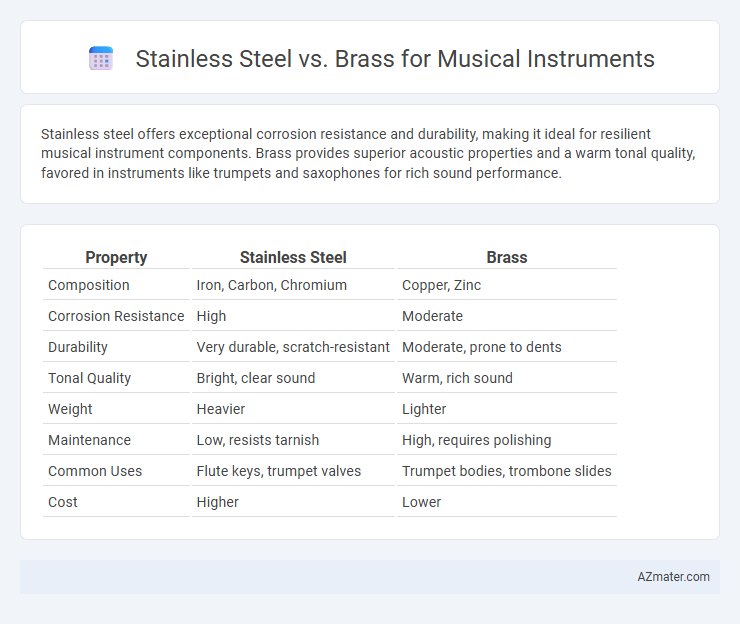Stainless steel offers exceptional corrosion resistance and durability, making it ideal for resilient musical instrument components. Brass provides superior acoustic properties and a warm tonal quality, favored in instruments like trumpets and saxophones for rich sound performance.
Table of Comparison
| Property | Stainless Steel | Brass |
|---|---|---|
| Composition | Iron, Carbon, Chromium | Copper, Zinc |
| Corrosion Resistance | High | Moderate |
| Durability | Very durable, scratch-resistant | Moderate, prone to dents |
| Tonal Quality | Bright, clear sound | Warm, rich sound |
| Weight | Heavier | Lighter |
| Maintenance | Low, resists tarnish | High, requires polishing |
| Common Uses | Flute keys, trumpet valves | Trumpet bodies, trombone slides |
| Cost | Higher | Lower |
Material Composition: Stainless Steel vs Brass
Stainless steel, primarily composed of iron, carbon, chromium, and nickel, offers exceptional corrosion resistance and durability, making it ideal for musical instruments exposed to moisture and frequent handling. Brass, an alloy of copper and zinc, is favored for its excellent acoustic properties, warm tone, and ease of machining, contributing to its widespread use in wind and brass instruments. The choice between stainless steel and brass significantly impacts instrument longevity, tonal quality, and maintenance requirements, with stainless steel providing resilience and brass delivering superior sound characteristics.
Sound Quality and Tone Characteristics
Stainless steel produces a brighter, more focused sound with enhanced sustain and resistance to corrosion, making it ideal for instruments requiring clear, cutting tones. Brass offers a warmer, richer tone with complex overtones and greater resonance, favored for its traditional, mellow sound quality in brass winds and certain string instruments. The choice between stainless steel and brass significantly impacts the instrument's timbre and projection, shaping its suitability for different musical styles and settings.
Durability and Longevity
Stainless steel offers superior corrosion resistance and maintains structural integrity under frequent use, making it highly durable for musical instruments exposed to moisture and varying temperatures. Brass, while traditionally favored for its warm tonal qualities, is softer and more prone to denting and tarnishing over time, which can affect instrument longevity. Choosing stainless steel ensures extended lifespan and consistent performance, particularly in demanding playing environments.
Maintenance and Care Requirements
Stainless steel instruments require minimal maintenance due to their corrosion resistance and durability, making them ideal for environments with high humidity or frequent exposure to moisture. Brass instruments, while offering superior acoustic qualities, demand regular polishing and careful handling to prevent tarnish and corrosion, especially in humid or salty conditions. Proper cleaning routines and occasional professional servicing are essential for brass to maintain both appearance and sound quality over time.
Weight and Playability
Stainless steel offers greater durability and corrosion resistance but tends to be heavier than brass, impacting the overall weight of the musical instrument. Brass, being lighter, often provides enhanced ease of handling and quicker response during play, contributing to better playability for wind and brass instruments. The choice between stainless steel and brass directly influences the balance, comfort, and agility required for optimal performance.
Corrosion Resistance and Environmental Factors
Stainless steel exhibits superior corrosion resistance compared to brass due to its chromium content, which forms a passive oxide layer preventing rust and tarnish in humid or salty environments. Brass, an alloy of copper and zinc, is more prone to oxidation and green patina formation when exposed to moisture and air pollutants, requiring regular maintenance to preserve sound quality. Environmental factors such as coastal air with high salinity significantly favor the durability of stainless steel instruments for long-term use.
Cost and Value Considerations
Stainless steel offers superior durability and corrosion resistance for musical instruments, often resulting in lower long-term maintenance costs despite a higher initial price compared to brass. Brass, favored for its warm tonal qualities, remains more affordable upfront but may require frequent polishing and repair due to its susceptibility to tarnishing and dents. Musicians seeking cost-effective investment prioritize stainless steel for longevity and value retention, while brass is preferred for budget-friendly options with distinct acoustic properties.
Suitability for Different Instrument Types
Stainless steel offers excellent durability and corrosion resistance, making it ideal for woodwind instruments like flutes and saxophones that require resilience against moisture and frequent handling. Brass provides superior acoustic properties with warm, rich tones favored in brass instruments such as trumpets and trombones, enhancing their sound projection and timbre. Choosing between stainless steel and brass depends on the instrument's design and desired tonal quality, with stainless steel preferred for modern, durable builds and brass for traditional, resonant sound.
Aesthetic Appeal and Customization Options
Stainless steel offers a sleek, modern aesthetic with a polished, mirror-like finish that resists tarnishing and corrosion, maintaining its visual appeal over time. Brass provides a classic, warm golden hue favored for its vintage and traditional look, which can develop a unique patina adding character as it ages. Customization options are more varied with brass, including engraving and diverse finishes like matte or lacquered coatings, while stainless steel customization often involves precise machining and surface treatments to enhance durability and style.
Popular Brands and Instrument Examples
Stainless steel is favored by brands like Yamaha and Pearl for its durability and corrosion resistance, commonly used in flutes and percussion instruments. Brass remains dominant in iconic brass instruments such as trumpets and trombones, crafted by manufacturers like Bach and Conn-Selmer, valued for its warm tonal qualities. Both materials influence sound production and instrument maintenance, with stainless steel preferred for modern, low-maintenance designs and brass celebrated for traditional acoustics.

Infographic: Stainless steel vs Brass for Musical instrument
 azmater.com
azmater.com